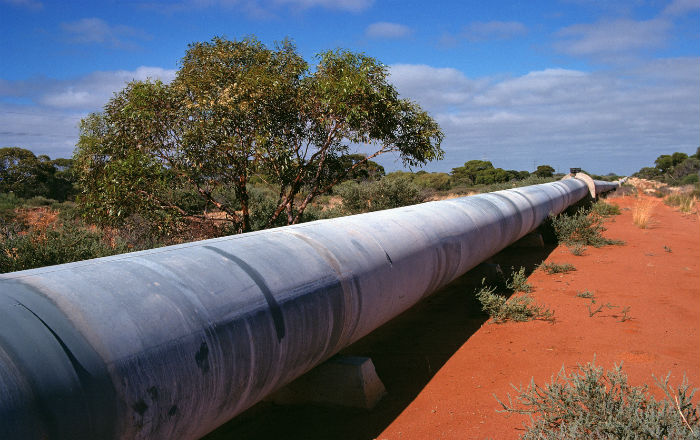 |
| Water Pipeline |
Written by Marcos Camargo
My mother, bless her soul, took a great interest in the education of her children. Some of my fondest memories were nights spent with her reading to us from classic children’s books. Among her favorite stories was an autobiographical account by western author Ralph Moody.
He set his playful yet poignant narrative Little Britches in the vicinity of Littleton, Colorado, just after the turn of the 20th century. Moody’s family made its living from dry farming—a rugged and unreliable existence. So it made sense that one of his prevailing themes centered on the importance of water rights. In Moody’s world, availability of water meant life or death. More than once his father came home late, dirty, and bruised. But his black eyes and cracked ribs did not come from the rough work of a dry farmer; instead, he incurred those wounds from community fights over water. These skirmishes were stirred up by men who took more than their fair share of that precious desert commodity. Until hearing Moody’s story, I had never thought of water as a scare resource.
I would stare out the window of my parents’ home in the Willamette Valley of Oregon, where the drizzle rarely stopped from November ‘til June, and wonder how anyone could ever suffer from a lack of rain. That all changed when I moved to Utah. The artificial green of the Southwest’s populous outcroppings cuts harshly against the beautiful desolation of the outlying desert regions. So immense is the contrast, it’s as though a simple brushstroke, rather than a complex irrigation system, drew the boundary between humanity’s oasis and nature’s wilderness.
A century after the Moodys’ struggles, most of us don’t even think about where our water comes from. Sure, you ask the average desert dwellers where their tap water originates, and they will probably give you some semi-correct answer: “from the ground” or “from the mountain runoff.” But the more important questions are how did it get here, to this tap, and how much did it cost, both in monetary value and in ecological destruction? As much as I’d like to get into the intricacies of the hidden costs of shipping water over mountains and through pipelines—such as the environmental and cultural degradation caused by building expansive infrastructure to carry water hundreds of miles—let’s focus on the real costs, the costs that hit us in the pocketbooks, at the cash register, and every time we’re forced to cut a check to Uncle Sam. With the recent plan to build a massively expensive new water project, the Lake Powell Pipeline (LPP), Washington County residents must consider the costs of convenience over conservation. The proposed pipeline would bring water from Lake Powell to Sand Hollow Reservoir—a nearly 140-mile journey over pristine desert and through cultural heritage sites. The project already boasts one of the highest price tags in state history. Currently, low estimates peg the cost at $1.4 billion. But if expense projections continue trending upward, as they have since the plan was first conceived, then we’re looking at an amount closer to three billion.
In a Deseret News article published Dec. 21, 2004, the estimated cost of the pipeline stood at $370 million, or $593 million adjusted for inflation by 2018. By Oct. 16, 2012, in an article titled “Lake Powell pipeline could quadruple water costs, U. economists say,” the Deseret News readjusted the figure to “at least a billion dollars.” This came at the same time that some University of Utah economists flat out suggested, “the project may be too expensive for Southern Utah residents to ever pay back.” As a hard dollar amount, the expense would equal “between $40 and $50 million a year.” But the Washington County Water Conservancy District (WCWCD) tells county residents not to worry, because the Lake Powell Pipeline Development Act (LPPDA) “allows the District to take and pay for water in blocks… with up to 50 years to repay for each block.” A comforting thought for a citizenry already mortgaged out for collateral on already existing government debt. Funding for the project has taken a controversial turn as well. Originally the plan was to pay for the project through raising the cost of building permits and impact fees (a ten-time increase by some estimates). If encouragement of growth is the ultimate goal of the LLP, an increase in permits and fees is nothing if not detrimental to the stated goal. But as the estimated expenditure has swelled, so have ideas on where to extract the money.
Now, 8 years after the Utah Legislature passed the LPPDA, lawmakers are seriously considering using statewide sales taxes to “offset” the unexpected growth in the LLP budget. As citizens consider the many effects of such a massive public works project, two factors must be kept close at mind. Is the LLP worth at least 50 years of debt, most of which will be shouldered by the younger generation? And why haven’t more practical alternatives, such as conservation programs and incentives (for example, mandated watering schedules that have already been implemented with great success in other states) been considered? A multi-billion dollar solution to a possible future water shortage should be the last option for a county of less than 200,000 inhabitants, particularly if this community wants to remain a pristine and affordable place to live.



